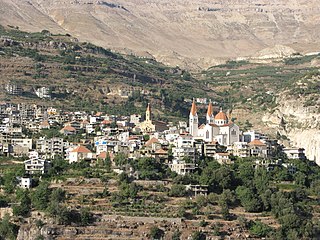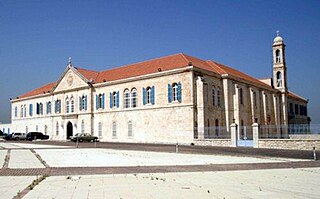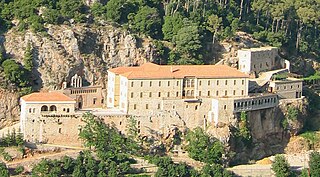
Qannoubine is a medieval monastery located within the Qannoubine region of the Kadisha Valley UNESCO World Heritage Site in Lebanon.

Qannoubine is a medieval monastery located within the Qannoubine region of the Kadisha Valley UNESCO World Heritage Site in Lebanon.
Qannoubine was home to Marina the Monk. [1] The monastery was founded in the 14th century. [2] It served Maronite Patriarchs from the 15th to the 19th centuries. [3] The monastery was recognised by UNESCO in 1998. [4]

Bsharri (Arabic: بشرّي Bšarrī; Syriac: ܒܫܪܝ; also Romanized Becharre, Bcharre, Bsharre, is a town at an altitude of about 1,450 m to 3,088 m. It is located in the Bsharri District of the North Governorate in Lebanon. Bsharri is the site of the only remaining original "Cedars of God", and is the birthplace of the famous poet, painter and sculptor Khalil Gibran. A museum in the town honours his life and work.

Kadisha Valley, also romanized as the Qadisha Valley and also known as the Kadisha Gorge or Wadi Kadisha, is a gorge that lies within the Bsharri and Zgharta Districts of the North Governorate of Lebanon. The valley was carved by the Kadisha River, also known as the Nahr Abu Ali when it reaches Tripoli. Kadisha means "Holy" in Aramaic, and the valley is sometimes called the Holy Valley. It has sheltered Christian monastic communities for many centuries. The valley is located at the foot of Mount al-Makmal in northern Lebanon.

Deir al-Qamar, is a city south-east of Beirut in south-central Lebanon. It is located five kilometres outside of Beiteddine in the Chouf District of the Mount Lebanon Governorate at 800 m of average altitude.

Amioun is the capital of the predominantly Greek Orthodox Koura District in North Lebanon.
Arbet Kozhaya, also known as Arbet Qozhaya or Arabet Kozhaya, is one of the fifty-six towns and villages, which make up the Zgharta District in the North Governorate of Lebanon.

Christianity in Lebanon has a long and continuous history. Biblical Scriptures purport that Peter and Paul evangelized the Phoenicians, whom they affiliated to the ancient patriarchate of Antioch. The spread of Christianity in Lebanon was very slow where paganism persisted, but it ultimately spread throughout the country, and even after centuries of Muslim rule, it remains the dominant faith of the Mount Lebanon region and has substantial communities elsewhere.

Bsharri District is one of the 7 districts of the North Governorate, Lebanon.

The Temple of Bacchus is part of the Baalbek temple complex located in the broad Al-biqā, Lebanon. The temple complex is considered an outstanding archaeological and artistic site of Imperial Roman Architecture and was inscribed as an UNESCO World Heritage Site in 1984. This monument to Bacchus is one of the best preserved and grandest Roman temple ruins; its age is unknown, but its fine ornamentation can be dated to the second century CE.

Byblos District, also called the Jbeil District, is a district (qadaa) of the Keserwan-Jbeil Governorate of Lebanon. It is located to the northeast of Lebanon's capital Beirut. The capital is Byblos. The rivers of al-Madfoun and Nahr Ibrahim form the district's natural northern and southern borders respectively, with the Mediterranean Sea bordering it from the west and Mount Lebanon from the east, separating it from the adjacent district of Baalbek in the Beqaa Valley.
The Cedars of God, located in the Kadisha Valley of Bsharre, Lebanon, are one of the last vestiges of the extensive forests of the Lebanon cedar that thrived across Mount Lebanon in antiquity. All early modern travelers' accounts of the wild cedars appear to refer to the ones in Bsharri; the Christian monks of the monasteries in the Kadisha Valley venerated the trees for centuries. The earliest documented references of the Cedars of God are found in Tablets 4-6 of the great Epic of Gilgamesh, six days walk from Uruk.

Bkerké is the episcopal see of the Maronite Catholic Patriarchate of Antioch of the Maronite Church in Lebanon, located 650 m above the bay of Jounieh, northeast of Beirut, in Lebanon.

Marina, distinguished as Marina the Monk and also known as Marinos, Pelagia and Mary of Alexandria, was a Christian saint from part of Asian Byzantium, generally said to be Lebanon. Details of the saint's life vary.

Qozhaya, also transliterated Qazahya is located in the Zgharta District in the North Governorate of Lebanon. It belongs to the Lebanese Maronite Order known as Baladites.

Bane is a Christian village located in the North Governorate of Lebanon. The inhabitants are Maronite Christians.

In Ehden, Lebanon, Mar Sarkis is a monastery of the Antonins. It is located in the Zgharta District of the North Governorate, in the Qozhaya valley. It overlooks Ehden, Kfarsghab, Bane and Hadath El Jebbeh. Given its exceptional location commanding the valley at 1500 meters altitude, the monastery is called the Watchful Eye of Qadisha.

The tourism industry in Lebanon has been important to the local economy historically and to this day comprises a major source of revenue for the country. Before the Lebanese Civil War, Beirut was widely regarded as "The Paris of the Middle East" or also "The Pearl of the Middle East" often cited as a financial and business hub where visitors could experience Levantine Mediterranean culture, cuisine, history, archaeology, and architecture of Lebanon.

The Maronites are a Christian ethnoreligious group native to the Eastern Mediterranean and Levant region of West Asia, whose members traditionally belong to the Maronite Church, with the largest concentration long residing near Mount Lebanon in modern Lebanon. The Maronite Church is an Eastern Catholic sui iuris particular church in full communion with the Pope and the rest of the Catholic Church.

Maronite Catholic Archeparchy of Tyre is an Archeparchy of the Maronite Church immediately subject to the Maronite Patriarch of Antioch. In 2014 there were 42,500 baptized. It is currently ruled by Archeparch Charbel Abdallah.

The Maronite Church is an Eastern Catholic sui iuris particular church in full communion with the pope and the worldwide Catholic Church, with self-governance under the Code of Canons of the Eastern Churches. The current head of the Maronite Church is Patriarch Bechara Boutros al-Rahi, who was elected in March 2011 following the resignation of Patriarch Nasrallah Boutros Sfeir. The current seat of the Maronite Patriarchate is in Bkerke, northeast of Beirut, Lebanon. Officially known as the Antiochene Syriac Maronite Church, it is part of Syriac Christianity by liturgy and heritage.

Çandarlı Castle, is the castle in the Çandarlı District of the Dikili district of İzmir. The exact year it was built is unknown, and it was restored by the Genoese in the 14th century. It was rebuilt in the 15th century by order of Grand Vizier Çandarlı Halil Pasha. The last restoration work started in 2009 was completed in 2014. UNESCO added the castle to the World Heritage Tentative List in 2013.
34°15′27″N35°56′59″E / 34.2574°N 35.9496°E